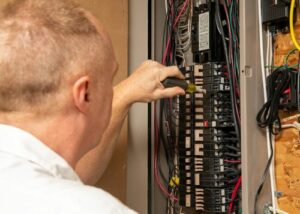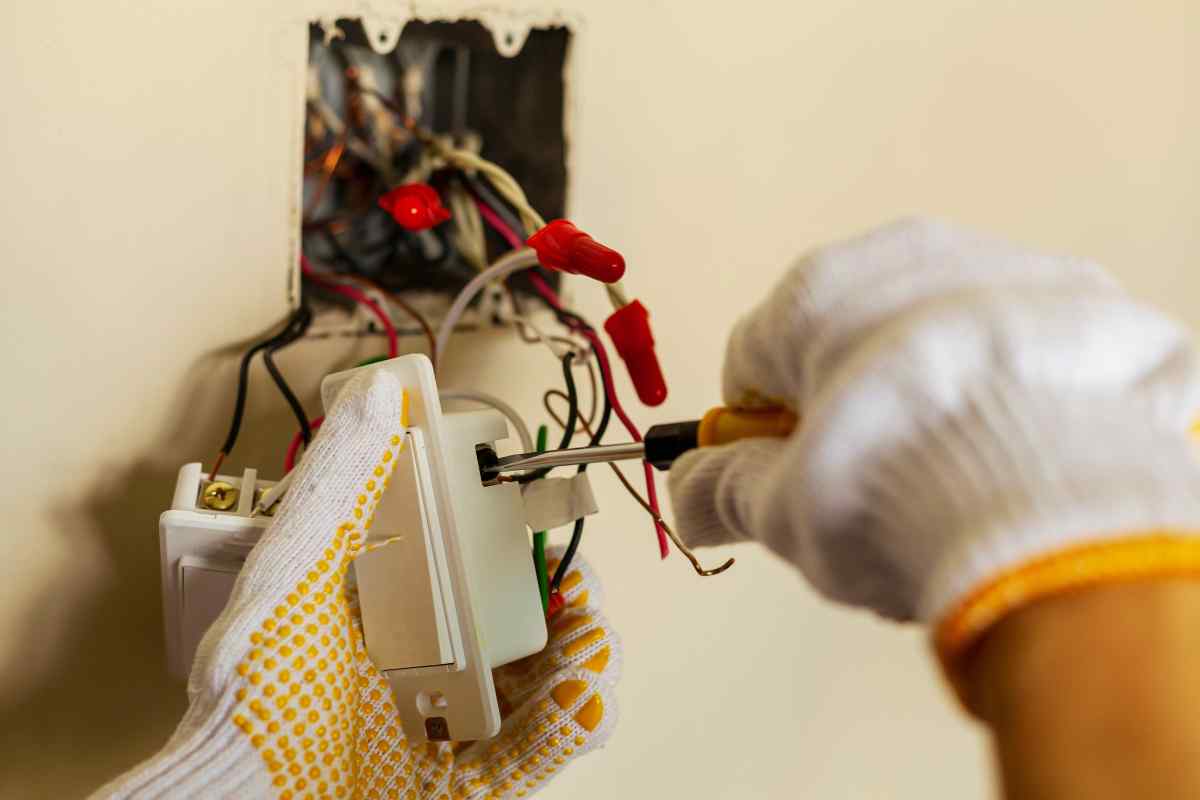Usual Electrical Problems Every Property Owner Ought To Find out about
Property owners frequently encounter different electrical problems that can impact security and functionality. Issues like flickering lights and tripped breaker are a lot more common than several recognize. These scenarios can indicate deeper electric issues that warrant focus. Recognizing the risks and indications associated with outdated electrical wiring and dead electrical outlets is crucial. What actions can be taken to avoid these issues? Exploring these typical electrical issues might disclose crucial insights for maintaining a secure home setting.

Flickering Lights: Causes and Solutions
Why do some home owners experience flickering lights? Flickering lights can be an usual inconvenience, often suggesting underlying electrical issues. One key reason is defective or loosened links within lights or electrical wiring, which can cause recurring power supply. Furthermore, utilizing high-wattage devices on the exact same circuit might trigger voltage fluctuations, causing flickering or lowering. Another possible problem is an overloaded circuit, where as well lots of tools draw power at the same time, stressing the electric system. Furthermore, abject or obsolete electrical wiring can add to inconsistent electric flow. In some instances, flickering lights may signify a trouble with the home's electrical panel or service line. Homeowners should address flickering lights without delay to avoid potential hazards. Solutions might consist of tightening up links, rearranging home appliance tons, or getting in touch with a licensed electrician for an extensive evaluation. Identifying the source can aid ensure a safe and stable electric system in the home.
Tripped Circuit Breakers: What You Required to Know
Have homeowners ever wondered what triggers their breaker to trip all of a sudden? This common concern typically occurs from an overload of electric circuits, where a lot of gadgets attract power at the same time. In such instances, the circuit breaker serves as a safety and security device, disrupting the flow of electricity to stop overheating and prospective hazards. One more constant reason is a brief circuit, which takes place when an online cord contacts a neutral wire, developing a surge of electricity that journeys the breaker. Ground mistakes can also lead to stumbled breakers; these take place when a live cord touches the ground or a grounded surface, posturing severe safety and security threats. Home owners need to regularly examine their use of high-wattage devices to avoid overloading circuits. Additionally, recognizing the function of circuit breakers can aid them react properly during a trip, guaranteeing their home remains well-kept and secure.
Out-of-date Wiring: Signs and Dangers
Out-of-date wiring can pose significant threats to property owners, often going unnoticed till issues arise. Residences constructed prior to the 1980s might still have aluminum circuitry or knob-and-tube systems, which are no longer taken into consideration safe. Indications of outdated wiring include flickering lights, frequently tripped breaker, or shedding smells near electrical outlets. These indicators may recommend that the electric system is loaded down or deteriorating.Additionally, property owners may observe blister marks around electrical outlets or switches, which can indicate overheating. The risk of electrical fires considerably increases with outdated wiring, as these systems were not made to manage contemporary electric tons. Property owners are encouraged to have their wiring inspected frequently, especially when remodeling or adding new appliances. By recognizing these indicators early, they can prevent hazardous situations and preserve a safer living environment. Updating to current electric criteria is an aggressive step in preserving home safety and security and efficiency.
Regularly Blown Fuses: Fixing Tips
Frequent blown merges can indicate underlying electric concerns that might originate from out-of-date circuitry or overloaded circuits. Home owners experiencing this trouble ought to initially determine the devices connected to the affected circuit. It is recommended to avoid using numerous high-wattage gadgets at the same time, as this can bring about circuit overload. If the problem lingers, checking the circuit box for signs of wear or damage is important; a faulty fuse box might require replacement.Additionally, looking for loosened connections within the circuit can assist prevent future incidents. Property owners should likewise confirm that the integrates being used are of the proper amperage, as using an inaccurate fuse can intensify the trouble. If these repairing suggestions do not solve the problem, seeking advice from a certified electrician is recommended to examine the electric system additionally. Addressing these issues immediately can assist mitigate risks and ensure the security of the home's electrical facilities.
Dead Electrical Outlets: Usual Causes and Fixes
When a property owner comes across a dead outlet, it can frequently provide disappointment and confusion. A number of typical causes might bring about this issue. One regular offender is a tripped circuit breaker, which can be easily reset. If any breakers are in the off go now setting, home owners should evaluate their electric panel to examine. Another opportunity is a damaged outlet itself, which may require replacement. Additionally, loose electrical wiring connections within the electrical outlet can interrupt power flow, making evaluation essential.Sometimes, the problem might stem from an overloaded circuit, particularly when several tools are linked. In such cases, rearranging the electric load can settle the problem. Homeowners should likewise consider the age of their electrical wiring; older systems may call for updates to satisfy modern-day electrical demands. If these steps do not rectify the circumstance, speaking with a licensed electrical contractor is a good idea to guarantee safety and security and proper diagnosis.
Electric Shocks: When to Be Concerned
Exactly how can homeowners figure out whether an electric shock warrants issue? Homeowners must first examine the severity and context of the shock. A moderate fixed shock, commonly felt when touching metal items, is usual and generally harmless. Nonetheless, if the shock occurs while connecting with a plugged-in home appliance or outlet, it may show an extra major issue.The location and regularity of the shocks are necessary. Repetitive shocks from the same source, particularly in damp areas like cooking areas or washrooms, could signal defective electrical wiring or inadequate grounding. Homeowners ought to likewise think about the experience of the shock; a shock that triggers discomfort or contraction is a lot more startling than a plain tingle.If there's any uncertainty, it review is suggested to seek advice from a certified electrical contractor. Disregarding possible electric risks can result in severe safety threats, consisting of fire or serious injury.
Overloaded Circuits: Avoidance and Security Actions
Overloaded circuits pose considerable dangers in household setups, often leading to electric fires or equipment damage (Level 2 Electrician). Homeowners have to identify the signs of an overloaded circuit, such as frequently stumbled breakers or dimming lights. Applying precautionary safety methods can help alleviate these dangers and guarantee a more secure living environment
Identifying Overloaded Circuits
What signs show that a circuit may be overloaded? Property owners must be watchful for numerous crucial indications. Often tripped circuit breakers or blown integrates suggest too much load on the circuit. Dimming or flickering lights, especially when various other appliances are in use, can symbolize a poor power supply. Additionally, electrical outlets or buttons that really feel warm to the touch may indicate getting too hot, a possible fire threat. Unusual humming sounds from outlets likewise necessitate interest, as they can represent electrical concerns. If appliances operate inefficiently or fall short to begin, it may be an indicator of an overloaded circuit. Recognizing try here these indications early can help stop serious electrical troubles and advertise a safer home atmosphere.
Preventive Safety And Security Practices
To preserve a efficient and safe electric system, house owners should implement precautionary safety methods that resolve prospective circuit overloads. One effective measure is to avoid connecting also numerous devices to a single electrical outlet, as this can exceed the circuit's capacity. Using power strips with built-in circuit breakers can aid distribute power safely. Home owners must also frequently inspect cables and appliances for damages and change any kind of malfunctioning equipment immediately. It is important to guarantee that breaker are operating properly and to be conscious of the total power level being utilized in each circuit. Additionally, getting in touch with a qualified electrical contractor for periodic evaluations can identify prospective concerns before they intensify, ensuring a more secure living setting and prolonging the life-span of electrical systems.
Frequently Asked Concerns
Exactly how Frequently Should I Have My Electrical System Inspected?
Routine examinations of electric systems are advised every three to five years. Homeowners ought to think about extra frequent checks if they experience issues, carry out renovations, or live in older buildings to ensure security and conformity.
Can I Take Care Of Electrical Troubles Myself or Hire an Expert?

What Are the Signs of an Electric Fire Risk?
Indications of an electrical fire danger consist of often stumbled breaker, flickering lights, melting smells, discolored outlets, or warm, buzzing wires. House owners must stay vigilant and seek specialist assistance if any one of these indications are existing.
Exactly how Do I Know if My Home Needs an Electric Upgrade?
To establish if a home needs an electrical upgrade, indications consist of frequent circuit breaker trips, outdated electrical wiring, not enough electrical outlets, flickering lights, and the existence of older electric panels, showing possible security threats and inadequacy.
Exist Specific Safety And Security Tips for Do It Yourself Electric Work?
When taking into consideration DIY electric work, one must always shut off power, utilize insulated tools, confirm circuit capability, adhere to local codes, and consult professionals for complex tasks to guarantee safety and prevent crashes. Another potential concern is an overloaded circuit, where as well lots of devices attract power concurrently, stressing the electrical system. The threat of electric fires noticeably increases with obsolete circuitry, as these systems were not developed to manage contemporary electric lots. Constant blown fuses can indicate underlying electrical problems that might stem from outdated wiring or overloaded circuits. To preserve a secure and efficient electric system, homeowners should execute preventative safety and security practices that address possible circuit overloads. Level 2 Electrician. Indications of an electric fire danger consist of frequently tripped circuit breakers, flickering lights, shedding odors, stained electrical outlets, or cozy, buzzing cords